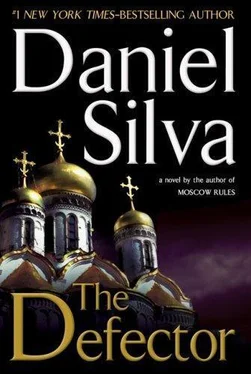UMBRIA, ITALY
GUIDO RENI was a peculiar man, even for an artist. He was prone to bouts of anxiety, riddled with guilt over his repressed homosexuality, and so insecure about his talents he worked only behind the protective shroud of a mantle. He harbored an unusually intense devotion to the Virgin Mary but loathed women so thoroughly he would not allow them to touch his laundry. He believed witches were stalking him. His cheeks would flush with embarrassment at the mere sound of an obscenity.
Had he followed his father’s advice, Reni would have played the harpsichord. Instead, at the age of nine, he entered the studio of the Flemish master Denys Calvaert and embarked on a career as a painter. His apprenticeship complete, he left his home in Bo logna in 1601 and traveled to Rome, where he quickly won a commission from the pope’s nephew to produce an altarpiece, Crucifixion of St. Peter , for the Church of San Paolo alle Tre Fon tane. At the request of his influential patron, Reni took his inspiration from a work hanging in the Church of Santa Maria del Popolo. Its creator, a controversial and erratic painter known as Caravaggio, was not flattered by Reni’s imitation and vowed to kill him if it ever happened again.
Before beginning work on Reni’s panel, the restorer had gone to Rome to view the Caravaggio again. Reni had obviously borrowed from his competitor-most strikingly, his technique of using chiaroscuro to infuse his figures with life and lift them dramatically from the background-but there were many differences between the paintings, too. Where Caravaggio had placed the inverted cross diagonally through the scene, Reni positioned it vertically and in the center. Where Caravaggio had shown the agonized face of Peter, Reni deftly concealed it. What struck the restorer most was Reni’s depiction of Peter’s hands. In Caravaggio’s altarpiece, they were already fastened to the cross. But in Reni’s portrayal, the hands were free, with the right stretched toward the apex. Was Peter reaching toward the nail about to be driven into his feet? Or was he pleading with God to be delivered from so terrible a death?
The restorer had been working on the painting for more than a month. Having removed the yellowed varnish, he was now engaged in the final and most important part of the restoration: retouching those portions damaged by time and stress. The altarpiece had suffered substantial losses in the four centuries since Reni had painted it-indeed, the midrestoration photos had sent the owners into a blue period of hysteria and recrimination. Under normal circumstances, the restorer might have spared them the shock of seeing the painting stripped to its true state, but these were hardly normal circumstances. The Reni was now in the possession of the Vatican. Because the restorer was considered one of the finest in the world-and because he was a personal friend of the pope and his powerful private secretary-he was allowed to work for the Holy See on a freelance basis and to select his own assignments. He was even permitted to conduct his restorations not in the Vatican ’s state-of-the-art conservation lab but at a secluded estate in southern Umbria.
Known as Villa dei Fiori, it lay fifty miles north of Rome, on a plateau between the Tiber and Nera rivers. There was a large cattle operation and an equestrian center that bred some of the finest jumpers in all of Italy. There were pigs no one ate, goats kept solely for entertainment value, and, in summer, fields filled with sunflowers. The villa itself stood at the end of a long gravel drive lined with towering umbrella pine. In the eleventh century it had been a monastery. There was still a small chapel and the remains of an oven where the monks had baked their daily bread. At the base of the house was a large swimming pool and a trellised garden where rosemary and lavender grew along walls of Etruscan stone. Everywhere there were dogs: a quartet of hounds that roamed the pastures, devouring fox and rabbit, and a pair of neurotic terriers that patrolled the perimeter of the stables with the fervor of holy warriors.
Though the villa was owned by a faded Italian nobleman named Count Gasparri, its day-to-day operations were overseen by a staff of four: Margherita, the young housekeeper; Anna, the gifted cook; Isabella, the ethereal half Swede who tended to the horses; and Carlos, an Argentine cowboy who tended the cattle, the crops, and the small vineyard. The restorer and the staff existed in something resembling a cold peace. They had been told he was an Italian named Alessio Vianelli, the son of an Italian diplomat who had lived abroad for much of his life. The restorer’s name was not Alessio Vianelli, nor was he the son of a diplomat, or even an Italian. His real name was Gabriel Allon, and he came from the Valley of Jezreel in Israel.
He was below average in height, perhaps five-eight, and had the spare physique of a cyclist. His face was high at the forehead and narrow at the chin, and his long bony nose looked as though it had been carved from wood. His eyes were a shocking shade of emerald green; his short dark hair was shot with gray at the temples. Entirely ambidextrous, he could paint equally well with either hand. At the moment, he was using his left. Glancing at his wristwatch, he saw it was nearly midnight. He debated whether to continue working. One more hour, he reckoned, and the background would be complete. Better to finish it now. The director of the Vatican Picture Gallery was keen to have the Reni on exhibit again by Holy Week, the annual springtime siege of pilgrims and tourists. Gabriel had pledged to do his utmost to meet the deadline but had made no firm promises. He was a perfectionist who viewed each assignment as a defense of his reputation. Known for the lightness of his touch, he believed a restorer should be a passing spirit, that he should come and go leaving no trace, only a painting returned to its original glory, the damage of the centuries undone.
His studio occupied what should have been the villa’s formal sitting room. Emptied of its furnishings, it contained nothing now but his supplies, a pair of powerful halogen lamps, and a small portable stereo. La Bohème issued from its speakers, the volume lowered to the level of a whisper. He was a man with many enemies, and, unlike Guido Reni, they were not figments of his imagination. It was why he listened to his music softly-and why he always carried a loaded Beretta 9mm pistol. The grip was stained with paint: a dab of Titian, a bit of Bellini, a drop of Ra phael and Veronese.
Despite the hour, he worked with energy and focus and managed to complete his work as the final notes of the opera faded into silence. He cleaned his brushes and palette, then reduced the power on the lamps. In the half-light, the background receded into darkness and the four figures glowed softly. Standing before the painting, one hand pressed to his chin, head tilted to one side, he planned his next session. In the morning he would begin work on the uppermost henchman, a figure in a red cap holding a spike in one hand and a mallet in the other. He felt a certain grim kinship with the executioner. In other lifetimes, concealed by other names, he had performed a similar service for his masters in Tel Aviv.
He switched off the lamps and climbed the stone steps to his room. The bed was empty; Chiara, his wife, had been in Venice for the last three days visiting her parents. They had endured long separations because of work, but this was the first of their own choosing. A loner by nature and obsessive in his work habits, Gabriel had expected her brief absence would be easy to bear. In truth, he had been miserable without her. He took a peculiar comfort in these feelings. It was normal for a happily married man to miss his wife. For Gabriel Allon-a child of Holocaust survivors, a gifted artist and restorer, an assassin and spy-life had been anything but normal.
Читать дальше












